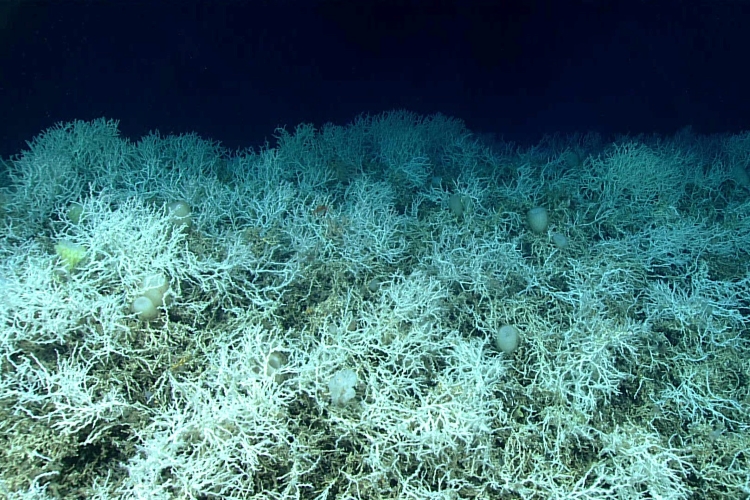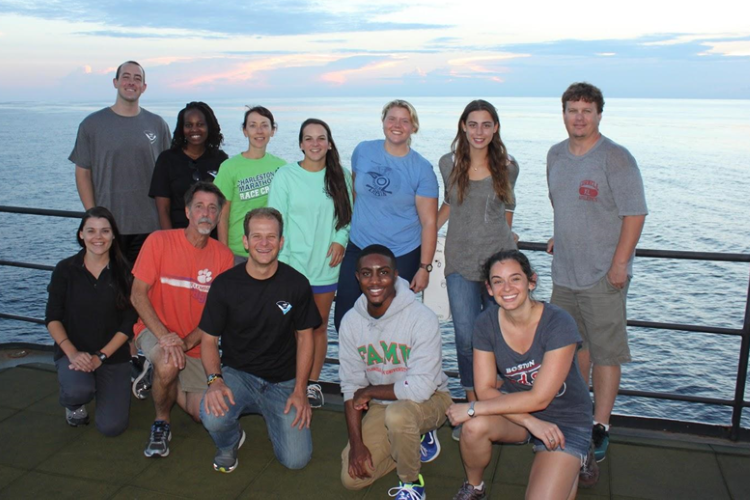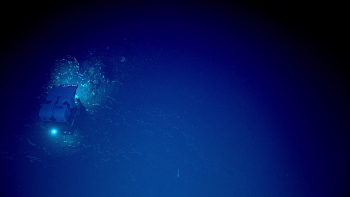The Deep Sea Coral Research and Technology Program completed two research initiatives in Southeast U.S. waters with a diverse network of partners. The first initiative (2009–2011) focused solely on the U.S. South Atlantic region. The second (2016–2019) covered a wider geographical range, which also included the Gulf of America and U.S. Caribbean waters. Notably, initiative partners explored the Caribbean Sea to record depths. These initiatives resulted in the discovery of enormous coral reefs in Southeast U.S. waters as well as a treasure trove of new data and information about deep-sea corals in the Gulf of America and U.S. Caribbean. Ultimately, the initiative findings have led to a wealth of habitat protections in the region. Between initiative years, smaller Program-funded projects in the region support conservation efforts.
The Southeast U.S. region includes federal waters of the Caribbean Sea, Gulf of America (formerly the Gulf of Mexico), and South Atlantic Bight. These waters are under the jurisdictions of the Caribbean, Gulf, and South Atlantic Fishery Management Councils. This region includes numerous areas where deep-water corals are protected, including the Flower Garden Banks National Marine Sanctuary in the Gulf of America.

Watch "Living in the Dark" to see deep-sea coral research in action in the Southeast!
The Program’s second Southeast U.S. research initiative was led by the NOAA National Centers for Coastal Ocean Science, in collaboration with NOAA Fisheries and the National Marine Sanctuaries program. Many other federal, state, and academic partners collected and analyzed data as well, including NOAA Ocean Exploration. The initiative sponsored 21 research expeditions to survey deep-sea coral and sponge ecosystems using ships, submersibles, remotely and autonomously operated vehicles, and other equipment. Complementary research projects conducted in partnership with universities focused on seafloor mapping, species identification, habitat suitability modeling, environmental and oceanographic monitoring, and data analysis. These collective efforts provided important information needed to aid resource managers in developing and evaluating management options for these valuable habitats—on which U.S. fisheries and communities depend.

“The cooperation and collaboration with NOAA’s Deep Sea Coral Research and Technology Program and Office of Ocean Exploration and Research [NOAA Ocean Exploration] over the past years to map, explore, and discover new complex deepwater ecosystems in the South Atlantic region continues to validate and reinforce the Council’s conservation of the most extensive deepwater ecosystem in the world. Who needs to go to Mars when every new dive into the abyss illuminates a world of wonder and discovery in systems that in some cases have been building over thousands of years?” — Jessica McCawley, former South Atlantic Fishery Management Council Chair
Researchers collected data across a spectrum, from images of rarely observed deep-water organisms, to counts and identification of organisms recovered from past expeditions, to seafloor surveys conducted during the initiative. These data and products informed several management decisions:
- Expansion of the Flower Garden Banks National Marine Sanctuary
- Designation of 21 new Habitat Areas of Particular Concern for deep-sea corals in the Gulf of America
- Designation of new special management zones with year-round seafloor protections in the U.S. South Atlantic
Initiative Highlights
Major accomplishments of the second initiative include the following:
- Expeditions resulted in a 450 percent increase in the number of coral and sponge observations in the West Florida Wall, an area of particular interest to the Gulf Fishery Management Council due to its significant coral aggregations. These records informed the Council’s decision to combine three small proposed protected areas into one much larger and more effective one (PDF, page 24).
- Mapping revealed that the central Blake Plateau, which was originally thought to be soft sediment, is actually covered with extensive mound features. They are composed primarily of Lophelia pertusa coral communities. Researchers have named this ecosystem “Million Mounds” and it contains some of the thickest Lophelia aggregates in the region.

- In a collaborative research project in Puerto Rico, local anglers deployed GoPro™ drop cameras to record video of deep-sea habitats. The project improved the understanding of relationships between commercially important snappers and coral and sponge communities.
- Successful telepresence-enabled expeditions allowed real-time participation from shore. Scientists involved more than 45 students, from the high school to Ph.D. level. They invited them to viewings and held laboratory classes to give the students hands-on experience with deep-sea corals.
- Researchers developed a web-accessible public geodatabase to share maps, coral observations, submersible dives, and managed area boundaries.
For more information and accomplishments, see the final initiative report. To learn more about impacts to deep-sea corals and sponges in the Southeast U.S., see Chapter 13 of the Program’s 2017 report: “The State of Deep‐Sea Coral and Sponge Ecosystems of the United States.” (PDF, 481 pages; Chapter: 38 pages)

The first initiative, which ran from 2009–2011, was led by NOAA Fisheries’ Southeast Fisheries Science Center. This initiative focused solely on the U.S. South Atlantic region to gather data relevant to South Atlantic Fishery Management Council decisions. The initiative resulted in new information on deep-sea coral and sponge locations in and around the Habitat Areas of Particular Concern. This information helped decision-makers determine if boundary adjustments were needed to protect nearby seafloor communities from fishing-related disturbances.
Initiative Highlights
Major initiative accomplishments include the following:
- Seven research cruises mapped over 10,000 square kilometers (3,860 square miles) of habitat along the outer continental shelf and slope between South Carolina and southern Florida.
- Expedition teams conducted dozens of submersible and remotely operated vehicle dives during the cruises. These dives resulted in the discovery of the region’s shallowest Lophelia pertusa bioherms—or ancient reefs—and documented many unprotected and previously unknown mounds of the reef-forming coral Oculina varicosa.
- Data collected during the first initiative informed management decisions that led to the protection of important coral and sponge communities in 2010. The South Atlantic Fishery Management Council designated five Habitat Areas of Particular Concern that contained nearly all of the known deep-sea coral habitat in its jurisdiction at the time. Three of these protected areas were later expanded in 2015.
Explore below for links to regional protected area websites, workshop reports, science plans, expedition reports, peer reviewed publications, and more.
- 2019 Southeastern U.S. Deep-sea Exploration – Remotely Operated Vehicle and Mapping Operations (NOAA Ocean Exploration)
- 2019 Southeastern U.S. Deep-Sea Exploration (EX1906 and EX1907) Summary (NOAA Ocean Exploration)
- Flower Garden Banks National Marine Sanctuary (NOAA National Marine Sanctuaries)
- Gulf Council Portal (Maps and deep-sea coral informational pages; Gulf of Mexico Fishery Management Council)
- Lophelia corals in the Gulf of Mexico (NOAA Ocean Exploration)
- NOAA Deep Sea Coral Research and Technology Program Southeast Deep Coral Initiative (SEDCI) 2016-2019: Final Report (NOAA Fisheries; 2021)
- South Atlantic Fishery Management Council Managed Areas Map Viewer (South Atlantic Fishery Management Council)
- Southeast Deep Coral Initiative (SEDCI): Exploring Deep-Sea Coral Ecosystems off the Southeast U.S. (NOAA National Centers for Coastal Ocean Science)
- Southeast Deep Coral Initiative: Exploring Deep-Sea Coral Ecosystems off the Southeast U.S. (NOAA Ocean Exploration)
- Southeast Deep-Sea Coral Digital Atlas (NOAA National Centers for Coastal Ocean Science)
- Southeast Fisheries Science Center Website (NOAA Southeast Fisheries Science Center)
- State of Deep‐Sea Coral and Sponge Ecosystems of the Southeast United States (NOAA Fisheries; 2017; PDF, 481 pages; Chapter: 38 pages)
List of Deep-Sea Coral Taxa in the U.S. Southeast Region: Depth and Geographic Distribution (v. 2021; PDF, 14 pages)
- List of Deep-Sea Coral Taxa in the U.S. Gulf of Mexico: Depth and Geographical Distribution (v. 2021; PDF, 16 pages)
- List of Deep-Sea Coral Taxa in the U.S. Caribbean: Depth and Geographical Distribution (v. 2021; PDF, 10 pages)
Through a wide variety of funding sources, the Program and initiative leads were able to build and maintain a broad portfolio of projects and partners, particularly during the second initiative. These partnerships have proven critical for developing and accomplishing research and management priorities in remote deep-sea habitats across the region. Research plans were developed in consultation with the Caribbean, Gulf and South Atlantic Fishery Management Councils. An interagency campaign known as DEEP Sea Exploration to Advance Research on Coral/Canyon/Cold seep Habitats (DEEP SEARCH), led by Bureau of Ocean Energy Management, U.S. Geological Survey, and NOAA Ocean Exploration, helped initiative researchers explore and characterize sensitive deep-sea habitats. Additionally, partners at the NOAA Resources and Ecosystems Sustainability, Tourist Opportunities, and Revived Economies (RESTORE) program in the Gulf of America, the Flower Garden Banks National Marine Sanctuary, the NOAA Coral Reef Conservation Program, and the U.S. Navy also contributed significantly to efforts to study and explore deep sea corals and sponges in the region. Due to the diversity of collaborators, the initiative used a wide array of remotely operated vehicles, autonomous underwater vehicles, manned submersibles, and angler partners to explore the seafloor and sample coral communities.

Academic and non-governmental partners were also indispensable in completing successful initiatives. Several cooperative institutes, particularly the Cooperative Institute for Marine and Atmospheric Studies at the University of Miami, Harbor Branch Oceanographic Institute at Florida Atlantic University, and the Northern Gulf Institute led by Mississippi State University played key roles in data recovery, collection, and analysis for initiative research projects. Woods Hole Oceanographic Institution, The Global Foundation for Ocean Exploration, University of North Carolina - Wilmington Undersea Vehicles Program, and Pelagic Research Services operated many of the submersibles used during initiative expeditions. Additionally, researchers from the College of Charleston, Institute for Socio-Ecological Research Caribe, Lehigh University, the London Natural History Museum, Nova Southeastern University, Temple University, University of Louisiana at Lafayette, the University of Miami, and other institutes led various initiative expeditions.
Furthermore, students from many academic institutions, including College of Charleston, Florida A&M University, Florida Atlantic University, Florida State University, Mississippi State University, Nova Southeastern University, Texas A&M University, and University of Texas participated at sea, in various research projects, and in hands-on laboratory training events, particularly during the 2016–2019 initiative.
